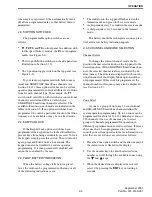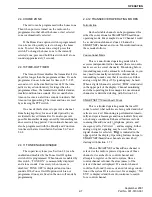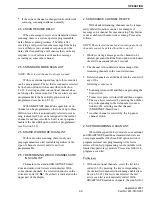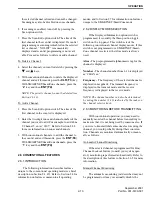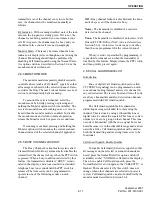
GENERAL INFORMATION
1-2
September 2001
Part No. 001-5100-001
Channels
A channel selects a radio channel or talk group in
a system as follows:
Conventional Analog Mode -
A channel selects a
specific radio channel, Call Guard (CTCSS/DCS)
squelch coding, and other parameters unique to that
channel.
Conventional Project 25 Mode -
A channel selects a
specific radio channel, NAC squelch coding, and other
parameters unique to that channel.
SMARTNET/SmartZone Operation -
A channel
selects a specific talk group, announcement group,
emergency group, and other parameters unique to that
channel.
A maximum of up to 256 channels can be
programmed with the preceding modes. The conven-
tional system can be programmed with up to 256 chan-
nels, and each of the SMARTNET/SmartZone systems
can be programmed with up to 256 talk groups
(channels).
Therefore it is theoretically possible to program
any combination of these systems that produces up to
256 total channels. However, the maximum number
may be limited by the available memory. For example,
since more memory is required to program a
SMARTNET system than a conventional system, the
total number of channels decreases as the number of
SMARTNET systems increases. The programming
software displays a bar graph which shows the amount
of available memory space that is used by the current
data. Refer to Section 3.1.10 for more information.
Zones
A zone is a collection of up to 16 channels of any
type (conventional or SMARTNET/SmartZone). For
example, a zone could include 12 conventional chan-
nels and 4 SMARTNET channels. Zones are similar to
banks used in other E.F. Johnson transceivers. One use
of zones may be to program the channels used for
operation in a specific geographical area. Up to 16
zones can be programmed.
1.2.6 SECURE COMMUNICATION
Secure communication is available with all the
preceding protocols. The following types of encryp-
tion are available:
Conventional Analog and SMARTNET/SmartZone
Operation
•
460 Scrambling (Transcrypt)
Conventional Project 25 Operation
•
DES-OFB
1.2.7 PROGRAMMING
Transceiver programming is performed using a
PC-compatible computer and an E.F. Johnson 5100
series programming cable and PCTrunk™ program-
ming software (see Table 1-1). Programming is
described in Section 3.
1.2.8 ALIGNMENT
Transceiver alignment is performed using the
same computer and cable used for programming (see
preceding section). In addition, special PCTune™
software, the Radio Interface Box (RIB), and a
computer cable are required. All adjustments are made
using the software (no manual adjustments are
required). Refer to Section 5 for alignment
information.
1.3 PRODUCT WARRANTY
The warranty statement for this transceiver is
available from your product supplier or from the
Warranty Department, E.F. Johnson Company, 299
Johnson Avenue, P.O. Box 1249, Waseca, MN 56093-
0514. This information may also be requested from the
Warranty Department by phone as described in
Section 1.7. The Warranty Department may also be
contacted for Warranty Service Reports, claim forms,
or any other questions concerning warranties or
warranty service.

















